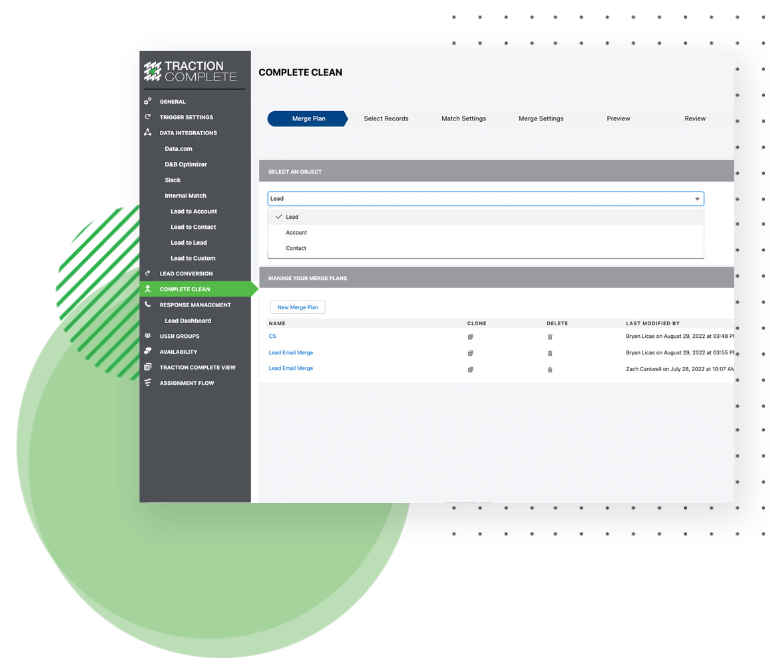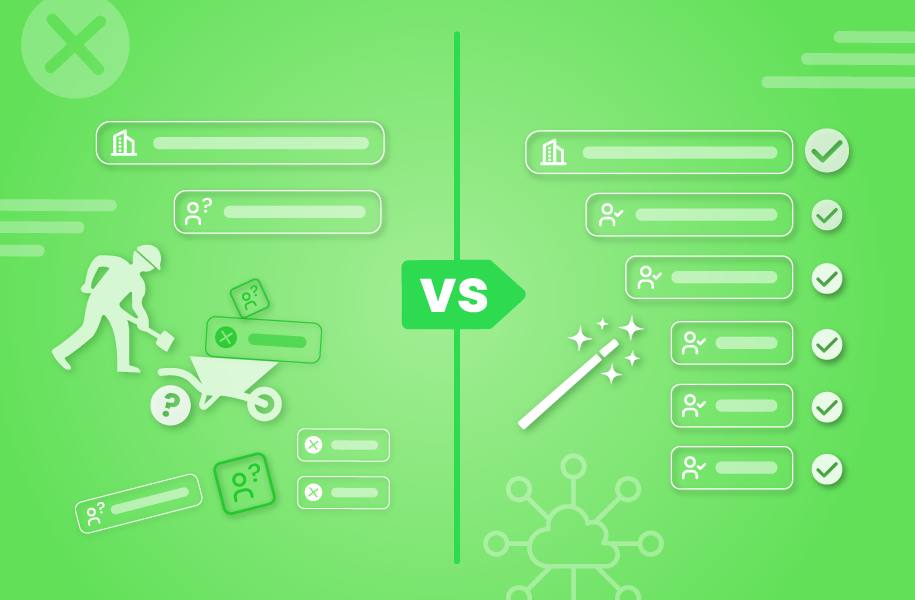Duplicate Data is Costing You
Does your real estate company deal with mistakes in property listings, client information, or transaction records?
When the data isn’t clean it costs your organization time, energy, and revenue. The average company loses 12% of its annual revenue due to dirty data.
Duplicate data can negatively impact areas of the business, such as:
- Missed opportunities from outdated listings and information
- A poor customer experience due to incorrect client information
- A negative reputation by not being up-to-date with listings or the real estate market
- Further reputation implications by being not up-to-date with the market
- Poor marketing campaign effectiveness
- Storage costs as your Salesforce data proliferates
- Data compliance issues
The bottom line is that dirty data costs real estate professionals effort, inefficiencies, and ultimately sales and revenue.
“Real estate professionals have a lot on their plates. From managing properties to dealing with clients, there’s always something to do. But amidst all that hustle and bustle, managing data often takes a back seat. Juggling all that information can be tricky, leading to errors, inefficiencies, and, ultimately, unhappy clients.
-Axia on The Importance of Data Quality in the Real Estate Industry
Real talk on real estate: What is the impact of duplicate data in your CRM?
Ever had records that have been created multiple times but aren’t merged into a single record? Leads, representing buyer interest, are the most common form of duplicate records because they can come from multiple sources. Duplicates can also include contacts and even accounts which causes further proliferation of your real estate data.
A perfect example of this is when a potential buyer uses multiple email addresses or fills out several forms for real estate projects.
For example, imagine if Pete Parker, a first-time home buyer, registers for several different real estate development projects.
Then, over the next two months, he also attends multiple open houses. But now, he’s using his full name (Peter B. Parker) and signing up with a different email address.
| Pete Parker | parkerp@hotmail.com | Source: Real estate pre-sale |
| Peter B. Parker | peterparker@gmail.com | Source: Open house |
If your team doesn’t have a process in place for managing duplicates, your CRM will think these are two different people – when in reality, there aren’t.
Not only can this create dozens to hundreds of duplicate records in your CRM, but it also creates confusion for sales agents as they try to understand “who is this person and what are they interested in?”
This same scenario happened to GTA Homes, a group of real estate brokers that provide services in buying, selling, and investing in homes. Part of their responsibilities include providing the Greater Toronto area with front-line access to condo projects, as well as educating their clients with market insights.
Due to prospects using multiple email addresses and completing forms for condo projects, there would be anywhere from two to 10 duplicate records for a single person.
Where does duplicate data come from in the real estate industry?
There are three main culprits from which duplicate data can come from.
Agents using Salesforce with a lack of process
The first source is real estate agents using Salesforce with a lack of process. Without a clear process around when and how to create new records, agents can freely create new accounts, leads, and contacts whenever they want.
Integrations
Tools outside of your CRM such as marketing automation, ERP, and even finance tools can push duplicate data into your system if there isn’t proper data governance in place.
Third-party data sources
The next culprit is data imports from third-party sources. This could be mergers or acquisitions between different real estate firms or list uploads from events. This is especially common when an automated lead-to-account matching tool isn’t being leveraged.
Why you need to deduplicate your Salesforce Org
Relationships are everything in real estate. Sellers need as much information as they can get, so they can close more deals with clients. Because of this, real estate firms are often worried about blocking incoming data or losing data.
As a result, they collect everything and end up with too many duplicate records to manage.
Taking the time to complete a deduplication project can work wonders for your real estate firm or brokerage – here’s why.
Creating a better buyer experience
Maintaining clean, accurate data is one of the most important things that a real estate firm can do to get the most out of their CRM. It’s the difference between agents being able to trust their data, or running into potential conflicts with other agents.
For GTA Homes, lose precious time combing through Salesforce, trying to determine if leads were net-new or already owned by another agent.
Here’s a common scenario – a real estate agent receives an inbound lead that registered for a development project. They appear to be a new prospect but the agent quickly learns that the person is already working with another agent. Or even worse, that they’re a longtime client.
Either way, that potential buyer is left with a bad taste in their mouth and a negative impression of the company.
Dirty data could also hurt property listings. Outdated listings can lead to missed opportunities, as well as damage the reputation of the firm, by appearing unreliable or not up-to-date with the fast-changing market.
Optimizing real estate marketing campaigns
Clean data plays a huge role for both your agents and your marketing team. Duplicate records will hurt your lead generation, lead management, email nurture campaigns, automation, and other kinds of marketing efforts.
Account-based marketing also has major payoffs in the real estate industry, including increased efficiency, personalized outreach, better alignment between marketing teams and sales agents, and increased revenue.
But what happens when marketing teams or real estate agents try to identify their target customers and the CRM is riddled with duplicates? There’s no clear way to measure touch points across the buying journey or the success of the program.
Also, if leads and contacts are duplicated, prospects and customers may receive multiple emails with poorly targeted messaging.
Deduplication ensures that marketing teams have the data they need to make better campaign decisions, target more effectively, and ultimately drive more revenue.
Minimizing the risk of anti-spam fines
Another often overlooked reason for strong duplicate management is to comply with data protection and privacy regulations such as CCPA, CASL, or DGPR.
If real estate agents are tasked with merging duplicate records, important fields such as “Opt-Out” or “Do Not Call” can be mistakenly overwritten, which can result in hefty fines (not to mention, agents are tasked with tedious manual work instead of selling!).
It’s essential to keep field retention policies in mind when crafting duplicate management processes.
Reducing storage cost
The last reason to dedupe your CRM is simple. Storage space in Salesforce is expensive and can quickly add up when your duplicates are out of control.
A mass deduplication project can uncover thousands of duplicate records and reduce storage costs drastically. For example, Traction Complete allowed GTA Homes to match and merge 170,000 duplicate records.
“Before, we had around 300,000 leads in Salesforce. Some leads had anywhere from two to 10 duplicates. With Complete Clean, we were able to dedupe down to 130,000 records without losing critical prospect data.”
-Chris MacLean, Salesforce Consultant at GTA Homes
How to Start Your Deduplication Project
Salesforce has two native functions to help manage duplicates – blocking and alerting.
The first option, alerting, displays a warning message when a user attempts to manually create a record that has a matching field to an existing record, such as a phone number. The drawback here is that alerts are only displayed for manual inserts and can be easily ignored by users.
The second option, blocking, prevents duplicates from entering the CRM when they are created by an API or import. While this is an effective method for exact matches, it can result in losing key data in situations that should otherwise be reviewed.
Real estate firms or brokerages that have smaller or newer orgs can rely on Salesforce’s native management tools and use manual merging to maintain a clear database. But what do you do if your organization adds hundreds or thousands of new records daily? In both cases you should be planning for scale.
Here’s what else you need to consider – dealing with duplicate data manually is an incredibly time-consuming task. According to Forbes, nearly two-thirds of an agent’s time is spent on non-revenue-generating activities.
You want your real estate agents to spend less time digging through records or trying to manually resolve duplicates – and more time selling.
Is it time to look for a data-cleansing tool? Do any of these apply to your business?
- Over 10,000 records in Salesforce
- 3 or more ways for records to enter Salesforce (ex. via integrations)
- Fear of losing data with Salesforce’s blocking method
- Need to match cross-object (ex. Lead to Contact matching)
- Need to automatically process duplicates as they enter (ex. duplicate prevention)
- Need to merge more than 2 records at a time
Proactive vs. Reactive Deduplication
If you’ve checked off any of the boxes above, your real estate company should consider using an automated data cleansing tool. As far as your options go, there are two strategies to consider.
For a moment, let’s step away from the world of real estate selling and compare data to dental hygiene – a trip to the dentist if you will. To keep your teeth (data) healthy, you have to combine reactive and proactive measures.
Reactive
Reactive would be a trip to the dentist where you get cavities filled, do root canals, or put on braces. In the lens of data, a reactive approach would involve mass deduplication and is recommended when your org has a large number of historical or existing records that require matching and merging.
In this case, third-party apps like Complete Clean can make this process a no-brainer. Users can identify groups of duplicates, create complex match, merge and field retention rules, preview how those rules will impact records, and generate reports to show stakeholders what records were merged – all with no code.

Most importantly, agents can keep the information around their buyers that’s important to them.
Proactive
A proactive approach is like remembering to brush and floss your teeth every day – once the dentist has addressed major issues, it prevents major work from being done in the future.
Proactive deduplication addresses records as they enter your CRM, like when Peter Parker registers for development projects under different names and email addresses. Each time a record is inserted, tools like Complete Leads can utilize rules created during the reactive process to automatically match, merge, and convert records in real-time as they enter Salesforce.

Ready to Drop Those Duplicate Records?
A clean CRM allows real estate companies simplify agent communication, provide a better home-buying process for their clients, and, ultimately, sell more homes.
Complete Clean takes away the fear around merging duplicate records, so that agents can feel confident that they’re keeping the correct data. It includes lead-to-account matching which will compare new records against the rest of your data – if a match is found, it will auto-merge and route the lead to the account owner, making sure it gets to the right realtor.





